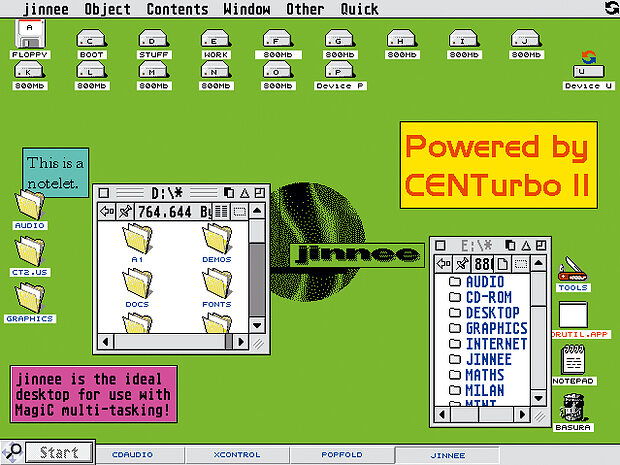Your Atari can connect to loads of peripherals you might not expect it to be able to use, including removable hard drives, DVD‑RAM drives, and CD writers. Derek Johnson plugs in.
In using this column to recount all the new and 'resurfacing' musical happenings in the Atari world, I find it's easy to forget the useful tools and utilities that work in the background while you're creating your music, a number of which have been upgraded over the last few months.
For example, Dr Uwe Seimet's HD Driver has reached v8. This established package works on all Ataris and many clones, with support for some alternative operating systems. It allows a wide variety of drives, including various flavours of SCSI, IDE/EIDE, Ultra DMA and ATAPI, to be used with an Atari. Removable media are also supported, so you can use SyQuest, Iomega, and even DVD‑RAM drives. Special tools are provided for configuring Iomega Zip and Jaz drives, so that you have almost all the functionality that Mac or PC users would have.
There appears to be no upper limit to drive size, though for really big drives — 1Gb or higher — ST and STe computers will require a compatible SCSI adaptor, such as WB Systemtechnik's Link 97; in any case, you'll need one of these in order to use SCSI drives at all. DOS/Windows media compatibility is provided, making for relatively straightforward data swapping between the Atari family and Macs or PCs. The software is compatible with the latest SCSI driver standard, providing "low‑level access" to SCSI, IDE and ATAPI devices such as CD‑ROM drives, CD writers, scanners and so on.
Worth noting is that v8 and higher versions of HD Driver are not compatible with Steinberg's Cubase Audio, due to the fact that HDD's latest SCSI driver doesn't allow two programs to compete for the SCSI buss. UK distributors Atari Workshop note that v7.9, which works perfectly with Cubase Audio, will be provided in these cases. HD Driver v8 costs £29.95 plus p&p; updates from v7.x cost £15, while earlier versions can be updated for £20, both plus p&p. The Link 97 SCSI adaptor mentioned above costs £59.95 plus shipping, from Atari Workshop; MegaSTe and towercase Link 97 options are available too.
www.atari‑workshop.co.uk
RAM Raider
A few months ago in this column, I provided a quick rundown of the things you can do to enhance your Atari, and as a result enterprising ST user John Heyward has emailed to point out that he's selling RAM upgrade kits for the STe family. On the face of it, the STe is easy to upgrade: unlike previous Atari computers, it came with four slots capable of accommodating SIMM (single in‑line memory module) RAM cards, rather than having its RAM soldered directly to its main board. The idea was that you would simply buy the RAM you required, to a maximum of four 1Mb modules, and slot them in. But anybody who's ever taken apart an Atari will know that this procedure isn't necessarily as straightforward as it could be. Luckily, John has included full instructions for disassembling an STe, installing the RAM, and putting the computer back together. The most important points to be aware of are that you need to remain grounded during the upgrade operation, and that the screws that hold the top panel in place are not all the same size. John also makes the sensible suggestion that various parts of your Atari could be sanitised while it's in bits!
John's RAM, mainly recycled from old PCs, costs a very reasonable £12.50 (US$21), including shipping, for the full 4Mb. That may not seem like much in a world of cheap RAM, where Macs and PCs can have Gigabyte RAM capacity, but when you're MIDI sequencing with compact ST applications, it's tons. If you have a pre‑STe Atari ST that's been modified with a RAM expansion board, but you haven't filled it with RAM, John's SIMMs should also be compatible with that.
W 4mbste.atari.org
News Stand
Just as I was finishing this column (at the end of May), I received notification that the May issue of netzine My Atari is available online to read, and that the April issue is available to download. The May issue's main focus is pre‑ST Atari 8‑bit machines, while the April issue features a breezy 12‑part web page design tutorial, and a review of Hector Facundo Arena's ultra‑compact, freeware, text–based Atari HTMLGen HTML tool.
Jinnee Out Of The Bottle
Manfred Lipert's Jinnee alternative Atari desktop has reached v2.5. To recap, this utility is compatible with all flavours of Atari, and is particularly well‑matched to the MagiC 6 alternative operating system. It borrows some of the best aspects of MacOS and Windows, and provides your Atari with access to: spring‑loaded folders; long file names; lots of customisation; icons for files; folders and programs on the desktop; drag‑and‑drop facilities; up to 50 programs launchable by keyboard shortcuts; notepad; and recoverable waste bin. Jinnee retails for £39.95, or £99.95 if bundled with MagiC 6, plus p&p. Upgrades from earlier versions cost £15; manual and disks must be returned for an upgrade.
www.atari‑workshop.co.uk
CD Drive Time
Anodyne Software's ExtenDOS Gold v3.3c is the latest release in a line of utilities that allows your Atari to use CD‑ROM drives and CD writers, including SCSI models if you have appropriate interfacing. The software lets you use audio and data CDs, and is compatible with most CD‑ROM formats; it also allows you to easily copy CD audio to your desktop, where it appears as WAV files. CD writers are supported for actually burning CDs, providing you have Anodyne's CD Writer Suite. ExtenDOS Gold v3.3c costs £39.95 plus P&P, and free updates can be downloaded from the Internet.
www.atari‑workshop.co.uk

